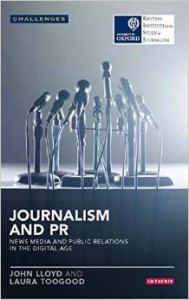Journalism and PR
About the author
Our guest authors are what make PR Place such a vibrant hub of information, exploration and learning.

‘More pervasive and less sinister’
The first thing to say about this new book from the Reuters Institute for the Study of Journalism at Oxford University is that it’s primarily about public relations, not about journalism. The book notes the shift in power between the two:
‘PR still needs journalism, which has always acted as a ‘third party endorsement’ of its claims But now it has other, often more powerful allies.’
These are interesting times for public relations, and it’s a pleasant surprise to have this acknowledged in a book written from a journalistic perspective.
The conventional view is also provided in the introduction: ‘Journalism, not much older as an organised profession than public relations, has come to depend on it even as it scorns it.’
This short book takes us through a ‘brief selective history’ of public relations. Edward Bernays takes centre stage, though John Lloyd (author of this section) acknowledges that Bernays ‘did not invent public relations’.
Lloyd argues that ‘engineering of consent’ was derived from an optimistic view that the state, supported by public relations, could be a force for good in society. Documentary film maker John Grierson also believed in ‘the educative, even liberating effect of public relations’.
‘Although public relations often proclaims its entrepreneurial lineage, it owes a good deal to state activism,’ Lloyd writes. Yet today, many critics equate public relations with private commerial gain rather than with public good.
It’s an argument made in Scott Anthony’s recent biography of Stephen Tallents, though this book is not cited here. Indeed, the over-reliance on US sources and US narratives is a weakness in this text, given the differences in the media culture and political systems between the US and the UK.
Drawing on analysis by Colin Byrne of Weber Shandwick, Lloyd presents three phases in the development of the PR-journalist relationship.
‘Hell’ was when PR practitioners were over-dependent on journalists, and communication was all one way. ‘Purgatory’ was when PR people began to make more use of internet channels. ‘Heaven’ is a world of content, with ‘public relations professionals … taking over much of what journalists had thought their own … from celebrity fluff to political analysis.’
It’s also a world in which PR practitioners encroach into the traditional realm of advertising through ‘native advertising’ (sponsored content).
Some newspapers are alert to this commercial opportunity too, and Lloyd cites The Guardian Labs and its £1 million plus contract with Unilever to promote ‘sustainability initiatives’.
In this context, Lloyd notes a shift from saying ‘we’re good’ to doing good.
‘The shift… is away from a strategy which demonstrated that corporations did good things – an approach known as Corporate Social Responsibility (CSR) – to one affirming that what the company is doing is itself good, or at least essential.’
There’s an interesting discussion of ethical principles in PR (pitting Lord Malloch Brown against Lord Bell), but the book acknowledges in the light of the Leveson Inquiry that ‘the largest part (by circulation) of the UK press has shown itself to be more ethically compromised than public relations.’
Turning to political communication, Lloyd notes that it is ‘at once more pervasive and less sinister than is commonly believed.’
Chapter 4, written by Laura Toogood, is written from a media rather than a PR perspective and provides an overview of the world of search engine optimisation and a discussion of ways to fund a newspaper’s web presence. Yet these commercial pressures are leading to a blurring of the lines between editorial and advertorial in a world of ‘brand journalism’. Every organisation (and even every individual) may now be a media company, but do they feel the need to disclose that a product endorsement on social media has been made because of a commercial relationship?
Red Bull is cited as a good example of a brand ‘that merges PR, online communications, and journalism’. It also has a website that looks more like a magazine than a commercial site.
Chapter 5 takes a look at public relations and political communication in three other countries: China, Russia and France to provide a contrast with the Anglo-Saxon emphasis. Lloyd finds that China is a contemporary example of the ‘engineering of consent’ because of restrictions on the media and the desire to promote harmony. When addressing Russia, he notes that while corporate PR follow universal principles, political communication varies widely according to different political systems.
Chapter 6 presents some conclusions and recommendations. Despite the focus of most of the book, these relate more to journalism than to public relations.
It’s a timely and interesting essay, but the book’s structure is sometimes muddled. The tensions in the relations between the royal family and the media at the end of the twentieth century have no place in a chapter on corporate PR.
Thought it’s a fluent book that’s not over-heavy on citations, the referencing of recent editions of classic texts can be misleading. The text implies that Walter Lippmann was writing at the end of the twentieth century rather than towards the beginning, and that Michael Frayn’s famous newspaper novel was written in the last decade rather than in the middle of the last century.
In summary:
‘The trades of political communication, together with corporate and celebrity PR and journalism itself, are all experiencing wrenching change. PR of all kinds is coming through it better than journalism, because it retains a business model … and is expanding its reach and competence.’
Journalism and PR: News Media and Public Relations in the Digital Age
By John Lloyd and Laura Toogood
IB Tauris, 2015, 138 pages